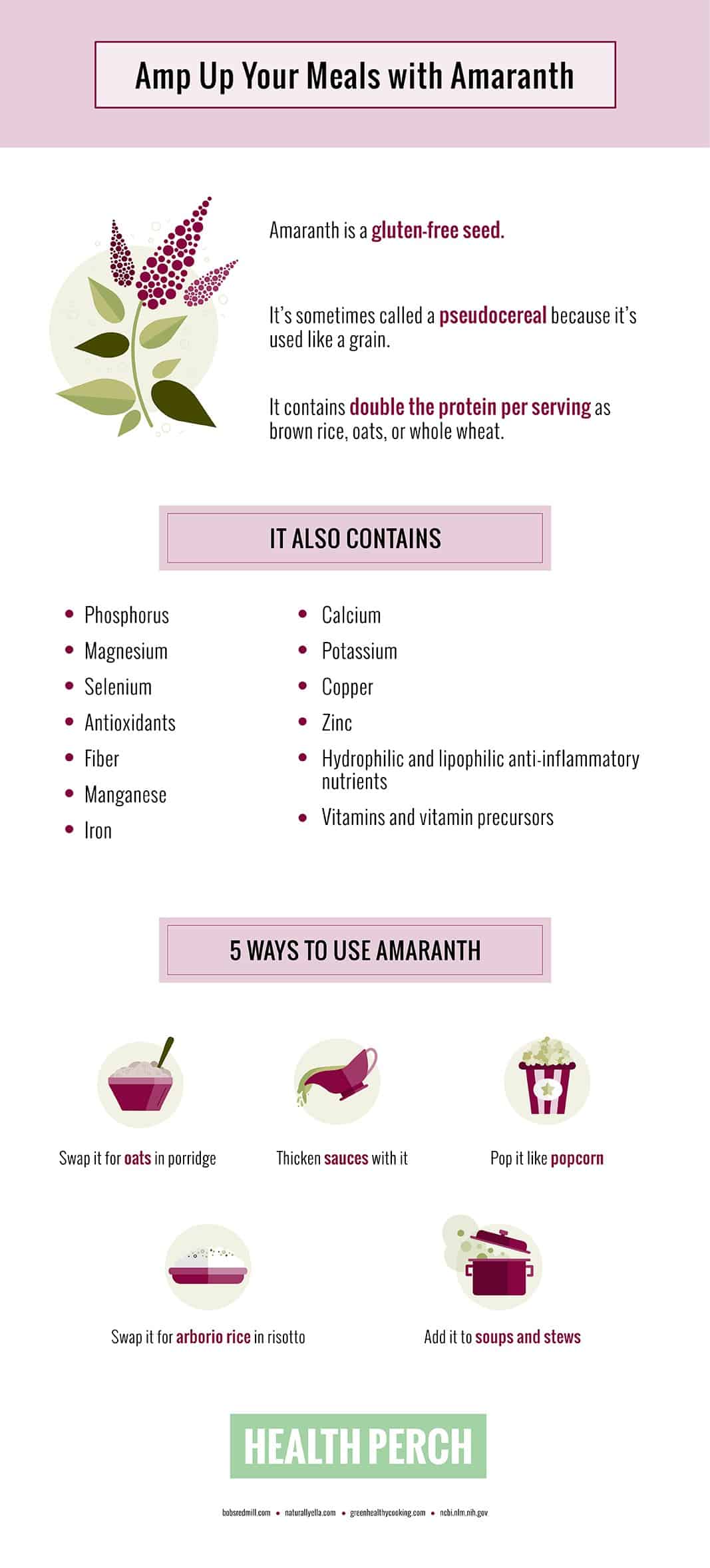
Protein-rich, gluten-free, and packed with antioxidants and minerals, versatile amaranth is an ancient grain that’s finding a place on modern tables.
Like quinoa and buckwheat, amaranth is a seed, not a grain. But it’s sometimes called a pseudocereal because it’s used like a grain in dishes. Civilizations such as the Aztec, Maya, and Inca have cultivated amaranth for thousands of years in South America and Mexico. Today, farmers grow amaranth worldwide, and more people are appreciating amaranth’s mild earthy, nutty flavor and aroma.
Health Benefits of Amaranth
Another reason amaranth is in demand? Amaranth’s nutrient combinations can contribute to improved health overall and may lower people’s risk of cardiovascular disease, obesity, diabetes, and cancer.
In addition to being naturally gluten-free and a plant-based source of complete protein (9g per serving), amaranth’s little seeds are packed with nutrition, including:
- Phosphorus
- Magnesium
- Selenium
- Antioxidants (including flavonols such as rutin and phenolic acids such as hydroxycinnamic acid)
- Fiber
- Manganese
- Iron
- Hydrophilic and lipophilic anti-inflammatory nutrients
- Calcium
- Potassium
- Copper
- Zinc
- Vitamins and vitamin precursors (such as ascorbic acid, riboflavin, tocols, and carotenoids)
The protein power of amaranth is especially worth celebrating. The seed has more protein than any grain with a balanced composition of amino acids. And the protein in amaranth is highly bioavailable, meaning it’s easy for the body to use it.

5 Simple Ways to Use Amaranth
In addition to its health benefits, amaranth is versatile. Available either as whole seeds or ground into amaranth flour, you can swap amaranth in for grains in the kitchen, including:
- Rice
- Couscous
- Pasta
- Millet
- Quinoa
- Oats
One thing to keep in mind is that when simmered, the consistency of amaranth is more mushy than fluffy — think risotto, not pilaf. Store whole amaranth in an airtight container in a cool, dark place. It will keep for up to six months in a pantry or up to a year in the freezer.
Amaranth takes to boiling, baking, roasting, popping, simmering, and other preparations. Use these ideas to try this ancient grain in meals and snacks.
1. Substitute amaranth for oats
With a subtle malty quality, amaranth can be subbed in for oats or wheat for a sweet or savory hot breakfast that’s similar to oatmeal, cream of wheat, or porridge.
Combine 1/2 cup amaranth and 1 1/2 cups of water in a small saucepan. Bring to a boil, reduce heat to low, then simmer uncovered for about 20 minutes, or until the amaranth has absorbed the cooking liquid. Serve immediately with your choice of seasonings and mix-ins.
2. Use amaranth instead of arborio rice for a savory risotto
For a risotto with an earthier quality, swap out arborio rice for amaranth. Use a 1:2 proportion of amaranth to liquid (such as 3 cups of amaranth to 6 cups of liquid).
Just as with a rice risotto, amaranth risotto pairs beautifully with stocks, meats, cheeses, seafoods, vegetables, mushrooms, etc. Aim to complement amaranth’s slightly nutty character, and you may discover a new favorite risotto.
3. Pop amaranth
The depth of amaranth’s natural nutty flavor makes it perfect for puffing and popping. Instead of popping corn, pop amaranth using this technique.
Expect amaranth to double in volume. For a one-cup serving, pop ½ cup. Don’t use a lidded pot, just a skillet or open Dutch oven, and don’t add any oil to the pan. Heat the pan over high heat for at least five minutes. Lightly toast one tablespoon of amaranth at a time, regularly shaking or stirring it until it pops. Amaranth pops quickly, so stay at the stove.
Popped amaranth is a perfect crunchy topping for salads or soups. Or you can eat it as a popcorn-like snack or mix it into homemade energy bars, burgers, or patties.
4. Use amaranth as a thickener
Thicken soups, stews, puddings, or sauces with amaranth. Instead of using flour or cornstarch for a roux, substitute whole amaranth or amaranth flour.
5. Add amaranth to soups and stews
Amaranth also adds chew, texture, and body to soups or stews. Add whole, uncooked amaranth during the last 30 minutes of simmering.
Another great thing about amaranth? It plays well with other grains and flours. Combine amaranth with other grains in your cooking such as brown rice, quinoa, wheatberries, and more.
Amazing Amaranth
Appreciated for its nutrition and versatility throughout history, amaranth is a true power grain that can increase the health and flavor of your foods. Whether as whole seeds or ground into flour, try amaranth to add some nutrition and nutty flavor to your cooking today.
